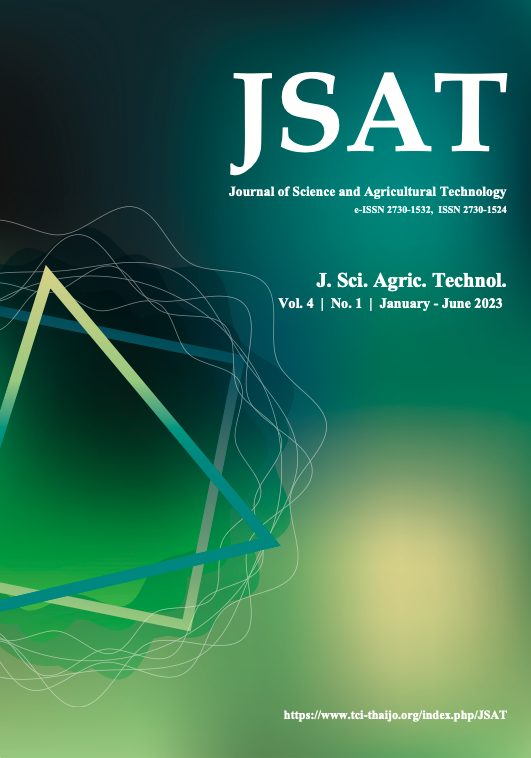Detection of Bacillus cereus group and emetic Bacillus cereus group strains in milk using multiplex polymerase chain reaction
Main Article Content
Abstract
Bacillus cereus group is one of the most frequently contaminated foodborne bacterial pathogen groups in milk and dairy products. Members of this group can cause emetic foodborne illness because of their ability to produce the emetic toxin. In this study, we aimed to investigate the occurrence of B. cereus group in raw milk and to develop a multiplex PCR method for detecting emetic B. cereus group strains. A total of 286 raw milk samples were collected from various dairy farming areas, including Mae Jo, Mae Wang, Sankampaeng, and Mae On, in Chiang Mai province, Thailand. The presence of B. cereus group species was examined using Bacara chromogenic agar, through which B. cereus group was found in 34.27% of the milk samples from all farming areas. A duplex PCR that detected its (universal gene) and motB (gene specific for the B. cereus group) was also performed, through which 47.90% of the milk samples were detected positive for the B. cereus group. Furthermore, a multiplex PCR targeting the motB, cesA, and its genes was developed. The developed method was successfully used to identify emetic B. cereus isolates from raw milk.
Article Details

This work is licensed under a Creative Commons Attribution-NonCommercial-NoDerivatives 4.0 International License.
References
Ahmed, A.A., Moustafa, M.K. and Marth, E.H. 1983. Incidence of Bacillus cereus in milk and some milk products. Journal of Food Protection. 46(2): 126–128. https://doi.org/10.4315/0362-028X-46.2.126.
Aksoy, B.T., Bozkurt, E., Sönmezoglu, Ö.A. 2021. Molecular detection of Bacillus cereus in milk by polymerase chain reaction. International Journal of Life Science and Biotechnology. 4(3): 389–399. https://doi.org/10.38001/ijlsb.912415.
Burke, N., Zacharski, K.A., Southern, M., Hogan, P., Ryan, M.P., Adley, C.C. 2018. The dairy industry: process, monitoring, standards, and quality. Descriptive Food Science. Descriptive Food Science. http://dx.doi.org/10.5772/intechopen.80398.
Chelliah, R., Wei, S., Park, B.J., Kim, S.H., Park, D.S., Kim, S.H., Hwan, K.S. and Oh, D.H. 2017. Novel motB as a potential predictive tool for identification of B. cereus, B. thuringiensis and differentiation from other Bacillus species by triplex real-time PCR. Microbial Pathogenesis. 111: 22–27. https://doi.org/10.1016/j.micpath.2017.07.050.
Coorevits, A., De Jonghe, V., Vandroemme, J., Reekmans, R., Heyrman, J., Messens, W., De Vos, P. and Heyndrickx, M. 2008. Comparative analysis of the diversity of aerobic-spore-forming bacteria in raw milk from organic and conventional dairy farms. Systematic and Applied Microbiology. 31(2): 12640. https://doi.org/10.1016/j.syapm.2008.03.002.
Ehling-Schulz, M., Lereclus, D. and Koehler, T.M. 2019. The Bacillus cereus group: Bacillus species with pathogenic potential. Microbiology Spectrum. 7(3). https://doi.org/10.1128/microbiolspec.GPP3-0032-2018.
Granum, P.E. and Lund, T. 1997. Bacillus cereus and its food poisoning toxins. FEMS Microbiology Letters. 157(2): 223–228. http://dx.doi.org/10.1111/j.1574- 6968. 1997.tb12776. x.
Jeßberger, N., Rademacher, C., Krey, V.M., Dietrich, R., Mohr, A.K., Böhm, M.E., Scherer S., Ehling-Schulz, M. and Märtlbauer, E. 2017. Simulating intestinal growth conditions enhances toxin production of enteropathogenic Bacillus cereus. Frontiers in Microbiology. 8: 627. https://doi.org/10.3389/fmicb.2017.00627.
Kalyan Kumar T.D., Murali, H.S., Batra, H.V. 2010. Multiplex PCR assay for the detection of enterotoxic Bacillus cereus group strains and its application in food matrices. Indian Journal of Microbiology. 50(2): 165–71. https://doi.org/10.1007/s12088-010-0002-4.
Marxen, S., Stark, T.D., Frenzel, E., Rütschle, A., Lücking, G., Pürstinger, G., Pohl, E.E., Scherer, S., Ehling-Schulz, M. and Hofmann, T. 2015. Chemodiversity of cereulide, the emetic toxin of Bacillus cereus. Analytical and Bioanalytical Chemistry. 407(9): 2439–2453. https://doi.org/10.1007/s00216-015-8511-y.
Miller, R.A., Jian, J., Beno, S.M., Wiedmann, M. and Kovac, J. 2018. Intraclade variability in toxin production and cytotoxicity of Bacillus cereus group type strains and dairy associated isolates. Applied and Environmental Microbiology. 84(6): e02479–e02417. https://doi.org/10.1128/AEM.02479-17.
Mosso, M.A., Arribas, M.L.G., Cuena, J.A. and Rosa de La, M.C. 1989. Enumeration of Bacillus and Bacillus cereus spores in food from Spain. Journal of Food Protection. 52(3):184–188. https://doi.org/10.4315/0362-028X-52.3.184.
Oliwa-Stasiak, K., Molnar, C.I., Arshak, K., Bartoszcze, M. and Adley, C.C. 2010. Development of a PCR assay for identification of the Bacillus cereus group species. Journal of Applied Microbiology. 108(1): 266–73. https://doi.org/10.1111/j.1365-2672.2009.04419.x.
Rajkovic, A., Uyttendaele, M., Vermeulen, A., Andjelkovic, M., Fitz-James, I., in’t Veld, P., Denon, Q., Verhé, R. and Debevere, J. 2008. Heat resistance of Bacillus cereus emetic toxin, cereulide. Letters in Applied Microbiology. 46(5): 536–541 https://doi.org/10.1111/j.1472-765X.2008.02350.x.
Schoeni, J.L. and Lee Wong, A.M.Y.C. 2005. Bacillus cereus food poisoning and its toxins. Journal of Food Protection. 68(3): 636–648. https://doi.org/10.4315/0362-028X-68.3.636.
Sinchao, C. 2021. Development of system for bacteria capable of producing heat-resistant toxins in milk and dairy products. Master’s thesis. Chiang Mai University, Thailand.
Stenfors Arnesen, L.P., Fagerlund, A. and Granum, P.E. 2008. From soil to gut: Bacillus cereus and its food poisoning toxins. FEMS Microbiology Letters. 32: 579–606. https://doi.org/10.1111/j.1574-6976.2008.00112.x.
Vidal, A.M.C., Rossi, O.D, Abreu I.L.D., Bürger, K.P., Cardoso, M.V., Gonçalves, A.C.S. and D'Abreu, L.F. 2015. Detection of Bacillus cereus isolated during ultra-high temperature milk production flowchart through random amplified polymorphic DNA polymerase chain reaction. Ciência Rural. 46(2): 286–292. https://doi.org/10.1590/0103-8478cr20141539.
Wang, J., Ding, T. and Oh, D.H. 2014. Effect of temperatures on the growth, toxin production, and heat resistance of Bacillus cereus in cooked rice. Foodborne Pathogens and Disease. 11(2): 133–137. https://doi.org/10.1089/fpd.2013.1609.
Wehrle, E., Moravek, M., Dietrich, R., Bürk, C., Didier, A., Märtlbauer, E. Comparison of multiplex PCR, enzyme immunoassay and cell culture methods for the detection of enterotoxigenic Bacillus cereus. 2009. Journal of Microbiological Methods. 78(3): 265–270. https://doi.org/10.1016/j.mimet.2009.06.013.
Worden, A. 2009. DNA Extraction - CTAB Method. Moss Landing, CA: Monterey Bay Aquarium Research Institute.
Yang, I.C., Shih, D.Y., Huang, T.P., Huang, Y.P., Wang, J.Y. and Pan, T.M. 2005. Establishment of a novel multiplex PCR assay and detection of toxigenic strains of the species in the Bacillus cereus group. Journal of Food Protection. 69(1): 5. https://doi.org/10.4315/0362-028X-68.10.2123.
Yobouet, B.A., Kouamé-Sina, S.M., Dadié, A., Makita, K., Grace, D., Djè, K.M. and Bonfoh, B. 2014. Contamination of raw milk with Bacillus cereus from farm to retail in Abidjan, Côte d’Ivoire, and possible health implications. Dairy Science and Technology. 94, 51–60. https://doi.org/10.1007/s13594-013-0140-7.


